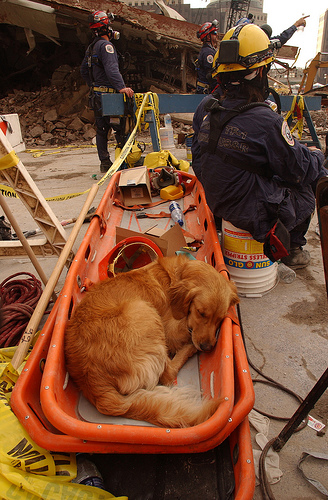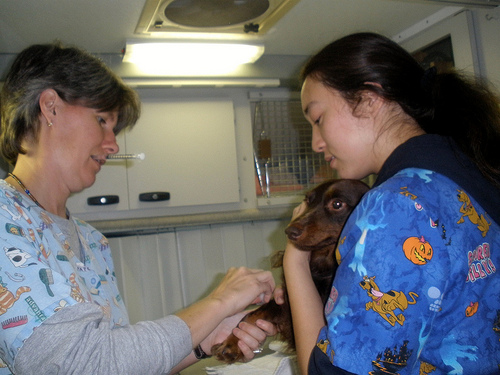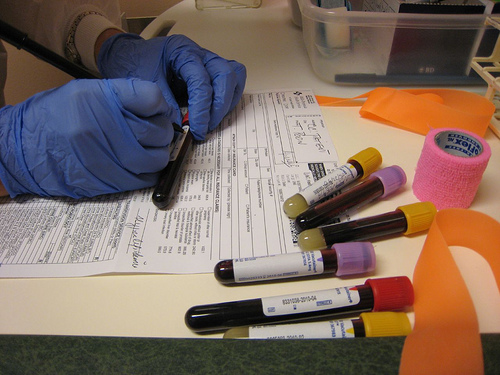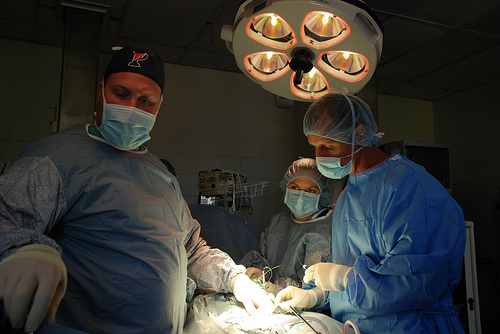
This article is courtesy of Mesothelioma.com.
 Often when tragedy strikes, emergency services deploy four-legged rescuers with their human partners to help in the disaster recovery process. These search-and-rescue dogs are a vital part to any disaster recovery plan from tragedies including 9/11, the Okalahoma City bombing, and other manmade catastrophes and natural disasters.
Often when tragedy strikes, emergency services deploy four-legged rescuers with their human partners to help in the disaster recovery process. These search-and-rescue dogs are a vital part to any disaster recovery plan from tragedies including 9/11, the Okalahoma City bombing, and other manmade catastrophes and natural disasters.
Search-and-rescue dogs, with their incredible instinct and intense training often go into places human rescuers are unable to reach, facing hazardous conditions and terrain. With their extraordinary hearing and sense of smell, these four-legged live-savers often find victims human rescuers may not be able to hear, see or reach.
However, there is a considerable amount of immediate physical danger search-and-rescue dogs face. Often, the immediate physical danger can turn into long-term, chronic health conditions.
Immediate health concerns for search-and-rescue dogs working during a disaster are include dehydration, damage to pads, cuts and abrasions. All human partners take incredible care of their dogs at a disaster site, including frequent eyewashes and baths, to ensure the dogs are fit and healthy. These decontamination procedures are usually for immediate and visible wounds and irritations.
However, with any disaster in a city, for example, there are many health hazards that human partners cannot see, touch, taste or even smell. This can lead to potentially, long-term, chronic health conditions for not only the human rescuers but also their canine partners.
Human rescuers have access to and are often required to wear protective gear when working at a disaster site, including helmets, gloves, clothing, boots and masks. Depending on the type of disaster, some search-and-rescue dogs may have protective boots for their feet or coverings for their bodies. Where humans can wear masks to prevent inhalation of toxins at a site, dogs have no such protection.
Dogs, with their extraordinary sense of smell, explore their world through their noses and mouths. Constantly licking their noses, sniffing the air and ground, search-and-rescue dogs have a higher risk of inhaling damaging toxins than their human partners inhale.
Besides the immediate danger of a disaster site -- broken glass, uneven surfaces, damaged buildings, fires -- there is a potential for hidden dangers that may have long-term health affects for search-and-rescue dogs.
During the 9/11 tragedy, the explosion and collapsing buildings released an incredible amount of diverse toxins, exposing not only humans but search-and-rescue dogs, posing a potentially terrible long-term health threat. At Ground Zero and Pentagon, search-and-rescue dogs encountered puddles of diesel fuel, gasoline, cleaning products, oils, glass, metals, asbestos and acids, among other visible material.
Further, the physical risks for search-and-rescue dogs are not limited to large-scale disasters. Any size or type of disaster in an urban setting poses the same physical threat level.
Long-term health issues developed from a disaster site are a serious concern for the partners of search-and-rescue dogs. Airborne toxins are just as damaging to dogs as they are to humans. Since the life span of a canine is on average twelve years, incubation and development of health conditions resulting from toxic exposure occurs more rapidly than in humans. Many serious human health conditions from toxin exposure can replicate in dogs.
As with asbestos exposure, possibly one of the most deadly toxins found at a disaster site, the incubation period of mesothelioma for humans can take as long as twenty-years, where, in dogs, can take as little as eighteen months for symptoms to present. All types of mesothelioma have been found in dogs exposed to chronic, high-levels of asbestos particles. During catastrophic disasters, many search-and-rescue dog teams work for lengthy periods, increasing their exposure to toxins.
When dogs develop mesothelioma, it is typically though inhalation of particles rather than ingestion. However, many dogs may accidentally ingest asbestos or other damaging particles from licking their noses, legs or paws.
Many other equally deadly diseases can develop in search-and-rescue dogs from any level of toxic exposure at disaster sites, including respiratory and gastrointestinal illnesses. Again, with mesothelioma, the gestation period for these diseases is quicker than in humans, and may present immediately or several months after exposure.
Sadly, many human partners of search-and-rescue dogs may use their dogs’ health as a marker for their own potential development of later health issues.
As long as there are disasters, using search-and-rescue dogs will be a critical part of saving lives. Though their human partners take incredible care of their furry companions, avoiding all potential health hazards at a disaster site simply may be impossible.
Image: Andrea Booher/FEMA
 Veterinary Specialists: Who Are They, Really
By T. J. Dunn, Jr., DVM
Tuesday, September
Veterinary Specialists: Who Are They, Really
By T. J. Dunn, Jr., DVM
Tuesday, September
 Remedies for Arthritis in Dogs: Glucosamine, Chondroitin Sulfate, Steroids, and NSAIDs
By T.J. Dunn, Jr., DVM
Glucosamine and Chon
Remedies for Arthritis in Dogs: Glucosamine, Chondroitin Sulfate, Steroids, and NSAIDs
By T.J. Dunn, Jr., DVM
Glucosamine and Chon
 Lumps and Bumps on Dogs
By T. J. Dunn, Jr., DVM
There are very few surpri
Lumps and Bumps on Dogs
By T. J. Dunn, Jr., DVM
There are very few surpri
 Reading the Blood Chemistry Panel: An Art and Science
Ever wonder what are the normal values for
Reading the Blood Chemistry Panel: An Art and Science
Ever wonder what are the normal values for
 Elective Surgery: Should You Or Shouldn’t You?
By T. J. Dunn, Jr., DVM
Just before
Elective Surgery: Should You Or Shouldn’t You?
By T. J. Dunn, Jr., DVM
Just before
Copyright © 2005-2016 Pet Information All Rights Reserved
Contact us: www162date@outlook.com